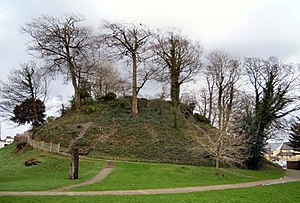Barnstaple Castle stood near what is now the centre of the town of Barnstaple, Devon (grid reference SS557332). When it was built, it was on the western side of the fortified town and commanded a good view of both the town and its important river crossings. The castle was built on top of an early medieval cemetery.

History
editBarnstaple Castle was founded in the 11th or 12th century; it was first mentioned in a 12th-century document. It is uncertain who founded the castle: if it was early it could have been built on the instruction of William the Conqueror as he subdued south-west England or if it was a later construction it could have been built for Juhel (Joel) of Totnes, who held the castle in the early 12th century.[1] Juhel also established Barnstaple Priory around 1107.[2][3]
King Stephen granted the castle to Henry de Tracy, one of his supporters. In the 12th century, stone buildings were erected on top of the motte, possibly during Henry de Tracy's tenure. The castle descended through his family to another Henry de Tracy,[4] who held the castle in 1228 when Henry III ordered the Sheriff of Devon to make sure that the walls of the castle did not exceed 10 feet (3.0 m) in height as recorded in the Close Rolls for that year.[5][6]
By the time of the death of the last Henry de Tracey in 1274, the castle was beginning to decay. According to an inquisition from 1281, building materials had been removed from the castle without permission and by 1326 the castle was a ruin.[5] According to John Leland's Itinerary, published in 1542, "There be manifest ruins of a great castle at the north west side of the town a little beneath the town bridge, and a peace of the dungeon yet standith."[7] Adam Wyat recorded that part of the castle walls blew down in a storm in 1601.[8]
Later history and investigations
editThe castle site was excavated in 1927 and 1975. The 1975 excavation revealed the presence of one hundred and five graves at the location. The excavation report, published in 1986, shows that the artefacts recovered at the location showed that the graves were most probably of Christians. Now only the tree covered motte remains.[9][10]
Since 1950, the castle has been designated a scheduled monument, which is intended to protect important archaeological sites.[10][11] The site is referred to simply as "Castle Mound" locally.[12]
References
edit- ^ Higham 1986, pp. 74–76.
- ^ Thompson 1986, p. 311.
- ^ Knowles & Hadcock 1953, p. 95.
- ^ Higham 1986, pp. 77–78.
- ^ a b Higham 1986, p. 78.
- ^ King 1983, pp. 115, 123.
- ^ Leland 1907, p. 169.
- ^ Wyat 1998, p. 88.
- ^ Fry 1980, p. 184.
- ^ a b Historic England. "Barnstaple Castle, Barnstaple (1020922)". National Heritage List for England. Retrieved 30 November 2021.
- ^ "Scheduled Monuments | Historic England". Historic England. Retrieved 30 November 2021.
- ^ Gussin, Tony (11 March 2024). "Barnstaple's Castle Mound will be lit up with artwork this Friday night". www.northdevongazette.co.uk. Retrieved 1 August 2024.
- Bibliography
- Fry, Plantagenet Somerset (1980). The David & Charles Book of Castles. Newton Abbot: David & Charles. ISBN 0-7153-7976-3.
- Higham, Robert (1986), "Appendix 1: The origins and documentation of Barnstaple Castle", Proceedings of the Devon Archaeological Society, 44: 74–81
- King, D. J. Cathcart (1983), Castellarium Anglicanum: An Index and Bibliography of the Castles in England, Wales and the Islands. Volume I, New York: Kraus International Publications, ISBN 0-527-50110-7
- Knowles, David; Hadcock, Richard Neville (1953). Medieval Religious Houses: England and Wales. Longmans.
- Leland, John (1907), Toulmin Smith, Lucy (ed.), The Itinerary of John Leland in or about the years 1535–1543. Parts I to III, London: George Bell and Sons
- Thompson, M. W. (1986). "Associated Monasteries and Castles in the Middle Ages: A Tentative List". Archaeological Journal. 143: 305–321. doi:10.1080/00665983.1986.11021136.
- Wyat, Adam (1998), Gray, Todd (ed.), The Lost Chronicle of Barnstaple, 1586–1611 (PDF), Devonshire Association, ISBN 0-85214-063-0
See also
editFurther reading
edit- Gribble, Joseph Besly (1830). Memorials of Barnstaple. J. Avery.
- Miles, Trevor J. (1986), "The Excavation of a Saxon Cemetery and part of the Norman Castle at North Walk, Barnstaple", Proceedings of the Devon Archaeological Society, 44: 59–84
- Oliver, Bruce W. (1928). "The Castle of Barnstaple". Transactions of the Devon Association. 60: 217–223.
- White, William (1879). History, Gazetteer and Directory of the County of Devon: Including the City of Exeter, and Comprising a General Survey of the County ... London: Simpkin, Marshall, & Co.
External links
edit51°04′51″N 4°03′46″W / 51.08083°N 4.06289°W